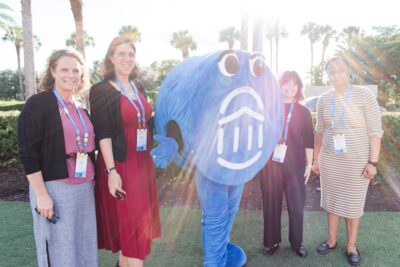What are students asking university chatbots?
AI tools are already reshaping the student experience. While usage spans a wide range of staff and student interactions, this blog focuses on what we can learn from student-facing chatbots—which have seen rapid adoption across higher education.
In the past 90 days, students and staff across more than 350 institutions had 25,000+ interactions with Navigate360’s AI Assistant. The themes in those queries, including academic support, advising access, financial uncertainty, and basic needs, offer a window into what students worry about most and when they seek help. For student success leaders, these patterns show what students need and help decide where to invest resources, how to communicate, and what services need to change.
The gap between student needs and campus support is growing
Across higher education, leaders know students expect 24/7 service and have little patience for delays. If they can’t resolve an issue right away, it often doesn’t get resolved at all. But most institutions are designed to operate on a 9-to-5 model, often compounded by siloed offices and overextended staff. Students trying to resolve a financial aid hold at 10 p.m. or get course planning guidance at midnight often hit a dead end. Usage data from Navigate360’s AI Assistant reveal just how large the gap between student needs and campus support has become.
In one 90-day period:
5,000+
students asked about courses, advisors, and campus resources.
75%
of student-facing chatbot queries arrived outside business hours—43% between 6 p.m. and 11 p.m.
32 %
of questions came in between midnight and 7 a.m.
Together, these dynamics explain not only why chatbot usage is high, but also why the questions themselves matter. When students ask things that existing resources don’t clearly answer, they surface real-time knowledge gaps. Each query highlights where staff can step in early to improve resources before more students stumble over the same roadblock.
Five insights from real AI usage data—and how student success leaders can respond
These insights come from thousands of real student interactions with Navigate360’s AI Assistant. Available 24/7, the Assistant answers questions instantly in 90+ languages, schedules advising appointments, manages to-dos, and guides course selection. It combines student data within Navigate360 and an institution-managed knowledge base to deliver accurate, student-specific answers. By analyzing the questions students ask most, often outside business hours, leaders can see where students struggle, what support they expect, and how to improve services to meet those needs.
1. Students want reassurance that they’re staying on track
Students often turned to chatbots to ask if they were “on track” with registration or credit momentum. These questions show that many students worry about whether they are making enough academic progress and don’t know where to find that information. Without timely reassurance, that uncertainty can lead to disengagement. Leaders can use chatbot data as an early-warning system and create proactive nudges that confirm progress before students lose confidence or stop out.
2. Students know when they’re struggling but don’t know what to do next
Many questions focused on academic standing. Students often wanted help understanding GPA calculations or what to do after earning a D or F. This shows that students are aware when they are struggling but often don’t know what actions to take. Leaders can respond by connecting chatbot interactions to early outreach through automation. For example, a question about probation prompts timely advisor follow-up. Chatbots can also guide students through key processes by breaking them into clear, step-by-step instructions, like how to schedule an advising appointment or how to complete a financial aid form.
3. Advising demand peaks when support is least available
Students frequently asked, “Who is my advisor?” followed by “When are they available?” The usage data revealed a majority of student chatbot queries came after 6 p.m., when advising offices are typically closed. Leaders can respond by piloting evening virtual advising hours and integrating chatbots with scheduling systems so students can book or reschedule directly. Monitoring caseload resolution time will show whether these adjustments actually improve access.
4. Specialized student groups face extra barriers
AI requests also centered on specific student groups such as military-connected students, TRIO-SSS participants, and students who had been reinstated or placed on probation. These populations often face compliance requirements that can complicate their experience. The number of these queries highlights how specialized groups are navigating more barriers than their peers. Leaders should treat chatbot logs as a signal of unmet needs. By reviewing which groups repeatedly surface requests, you can create tailored communication and outreach strategies close those gaps.
5. Students use AI to ask for sensitive help they may not voice elsewhere
Some of the most telling student questions had little to do with academics: “Where do I get clothes for an interview?” “How do I find an on-campus job?” “What should I do if I need food or housing?” These queries underscore that students view AI tools as safe entry points for sensitive or stigmatized needs. Leaders can use this insight to normalize help-seeking and connect chatbots directly to resources like food pantries, emergency aid, and career closets. Reviewing logs regularly can also reveal emerging needs that students may never voice face-to-face.
Key implementation considerations
To unlock full value, leaders should treat AI usage as a feedback channel, not just a service tool. A few principles can guide adoption:
- Create a cross-functional team to review chatbot logs weekly. Assign ownership for updating answers and for acting on patterns.
- Start with high-volume FAQs, then expand to processes like appointment scheduling or GPA guidance.
- If hundreds of students ask about a certain hold, the solution isn’t just writing a better answer, it’s fixing the hold policy or communication.
- Disaggregate data to see if first-generation, Pell-eligible, or military students are more likely to surface in certain categories of queries.
Tell students when they’re interacting with AI, explain how escalations work, and follow through quickly when a handoff to staff is required.
Every 30 to 60 days we generate a top-ten list of unclear questions and ask offices to fill those gaps. We feed the updates back in and students get better answers immediately.
– Brian Bunkwald, Assistant Dean for Student Achievement
Hunter College, discussing their progress with EAB’s AI Assistant for students
Turn everyday questions into strategic insights
The promise of AI in higher education is not just faster answers. It is clearer visibility into what students need, when they need it, and how institutions can respond. In just 90 days, students and staff asked more than 25,000 questions through Navigate360’s AI Assistant. These interactions paint a hidden picture of the student experience, one that reveals specific barriers, unmet needs, and opportunities to improve support.
When students raise questions that aren’t addressed in current resources, they surface real-time knowledge gaps. Each query becomes a signal that helps staff prioritize improvements without waiting for surveys, complex data analysis, or IR support. The cycle is continuous: students raise issues, staff refine content and workflows, and outcomes improve with each iteration.
AI chatbots are only one part of Navigate360 AI. Built on more than 20 years of EAB research, the platform brings together student-facing support, staff tools, and the Smart Network to give leaders a clear view of student needs and the ability to act on them. Because these tools are built into Navigate360, insights turn directly into improvements that help students succeed.

More Blogs

Four signs it’s time to break up with your student CRM

Three lessons from 1,200 student success leaders on higher ed’s future
